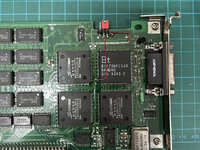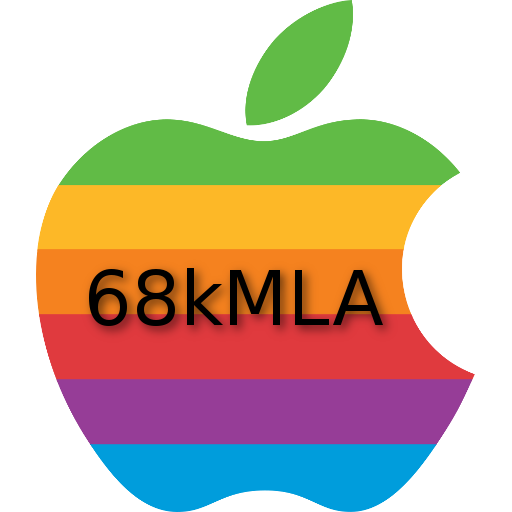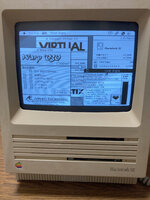jmacz
Well-known member
I had picked up a set of 3 NEC 15" AccuSync 52V LCD monitors a while back to get native 1024x768 resolution from my set of SuperMac Spectrum 24 cards. The LCD panels are native 1024x768 and support both 60Hz and 75Hz. But once hooked up, I was getting washed out colors on the panels. All three were exactly the same. I had posted about this before and gotten suggestions to use the Gamma control panel to help. It did help but still wasn't great. Then I found a hidden service menu within the LCD on screen controls which let me dial down the gain. That also helped a lot but still not great. So I've had a sub optimal result for a while now.
Recently in @bigmessowires's thread about his syncinator beta program, there was a conversation about washed out colors and @bigmessowires mentioned how this could be caused by the sync on green signal, well, sync on red/green/blue (all channels). If the monitor doesn't support these sync signals, it could cause it to fail to correctly determine its color range, or these signals could raise the floor on the black signal causing the washed out look.
I went to test this out by putting the SuperMac Spectrum cards RGB signals into a scope. Sure enough, the sync signals were there, on all three channels (red, green, blue). My NEC LCDs don't seem to support this hence the washed out colors.
I figured it was the RAMDAC that would be adding these signals to the red/green/blue channels so took a look at the datasheet. All the RAMDACs on my SuperMac Spectrum cards (24/III, 24/IV, 24/V, 24/PDQ) have RAMDACs that allow this signal to be optionally added. But you can also ground the SYNC pin to disable this. The SuperMac cards have this pin enabled. I tried lifting this SYNC pin and grounding it. It worked. The colors were no longer washed out and looked normal. Fantastic! But now, how to make this configurable.
I then decided to take a look at the ROMs for these cards to see whether the monitor configurations (stored in ROM and shown in the control panel) had a hidden flag for enabling/disabling sync on the RGB channels (ie. send a signal to the SYNC pin on the RAMDAC). I could make out a lot of the configurations (resolution, oscillator requirement, etc) but there's a lot of bits in each record. I was about to start looking at some of the code in the ROM when I noticed on the board that the sync signal seems to be going both to the SYNC pin on the RAMDAC as well as to the DB15 pins. This probably means I can't selectively turn off just the sync to the RGB channels as turning that signal off means it would disable the other sync pins on the DB15 cable.
So I decided to punt on the ROM and just hack something on the card itself.

Crude. But it's configurable now via the jumper. Pin 1+2 will enable sync on the RGB channels for my monitors that need that. And pin 2+3 disables it for my monitors that don't support sync on the RGB channels and want separate sync.
cc: @trickydee
Recently in @bigmessowires's thread about his syncinator beta program, there was a conversation about washed out colors and @bigmessowires mentioned how this could be caused by the sync on green signal, well, sync on red/green/blue (all channels). If the monitor doesn't support these sync signals, it could cause it to fail to correctly determine its color range, or these signals could raise the floor on the black signal causing the washed out look.
I went to test this out by putting the SuperMac Spectrum cards RGB signals into a scope. Sure enough, the sync signals were there, on all three channels (red, green, blue). My NEC LCDs don't seem to support this hence the washed out colors.
I figured it was the RAMDAC that would be adding these signals to the red/green/blue channels so took a look at the datasheet. All the RAMDACs on my SuperMac Spectrum cards (24/III, 24/IV, 24/V, 24/PDQ) have RAMDACs that allow this signal to be optionally added. But you can also ground the SYNC pin to disable this. The SuperMac cards have this pin enabled. I tried lifting this SYNC pin and grounding it. It worked. The colors were no longer washed out and looked normal. Fantastic! But now, how to make this configurable.
I then decided to take a look at the ROMs for these cards to see whether the monitor configurations (stored in ROM and shown in the control panel) had a hidden flag for enabling/disabling sync on the RGB channels (ie. send a signal to the SYNC pin on the RAMDAC). I could make out a lot of the configurations (resolution, oscillator requirement, etc) but there's a lot of bits in each record. I was about to start looking at some of the code in the ROM when I noticed on the board that the sync signal seems to be going both to the SYNC pin on the RAMDAC as well as to the DB15 pins. This probably means I can't selectively turn off just the sync to the RGB channels as turning that signal off means it would disable the other sync pins on the DB15 cable.
So I decided to punt on the ROM and just hack something on the card itself.

Crude. But it's configurable now via the jumper. Pin 1+2 will enable sync on the RGB channels for my monitors that need that. And pin 2+3 disables it for my monitors that don't support sync on the RGB channels and want separate sync.
cc: @trickydee


